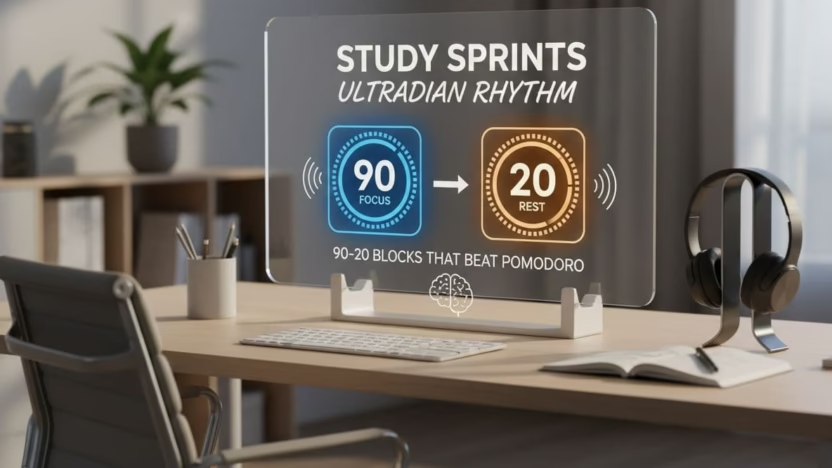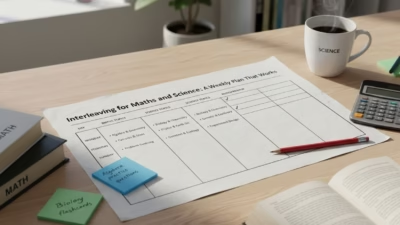Ever start a task, find your flow, then a timer tells you to stop at 25 minutes? Frustrating. Many students use 25-5 Pomodoro blocks, but deeper work often needs a longer groove. The science says your brain runs in natural 90 minute energy waves, followed by a short recovery. That rhythm is your friend.
Here is the idea. 90-20 study sprints use one 90 minute block for focused work, then a 20 minute active break. You ride the wave when your brain is primed, then you reset before the next lift. It helps most when you need depth. Think problem sets, essay drafting, languages, labs, coding, and exam revision.
You will get clear steps, practical examples, and a fair comparison with Pomodoro. You will see how many cycles to try in a day, how to avoid burnout, and how to spot real signs you need a break. Keep it simple, make smart tweaks, and track what works.
Key Takeaways
- Ultradian rhythm means your brain focuses best in about 90 minute waves, then needs a short reset.
- 90-20 sprints cut context switching, so you think deeper, remember more, and finish harder tasks faster.
- Use the 20 minute break for active recovery, not doom-scrolling. Move, breathe, hydrate, get light and fresh air.
- Pomodoro can still work for admin or short tasks. 90-20 is better for deep work like essays, maths proofs, or past papers.
- Start with 1 to 2 cycles a day, cap at 3 to 4 on heavy days, and protect sleep.
- Make a simple sprint plan. One clear goal, mini-milestones, a timer, and a quick score at the end.
Table of Contents
- Key Takeaways
- What is the ultradian rhythm and why 90-20 beats Pomodoro for deep study
- How to run 90-20 study sprints step by step
- Make 90-20 work for your subject, schedule, and energy
- Frequently Asked Questions About 90-20 Ultradian Study Sprints
- Can I shorten the 90 minutes if I feel tired?
- What if I only have 60 minutes between classes?
- Is a 20 minute break too long, will I lose focus?
- How many 90-20 cycles should I do in a day?
- Can I use 90-20 for group study or lab work?
- Does caffeine help or hurt a 90-20 sprint?
- How is 90-20 different from flow state sprints?
- Conclusion
What is the ultradian rhythm and why 90-20 beats Pomodoro for deep study
Your energy and focus rise and fall through the day in cycles. These ultradian cycles are roughly 90 minutes long. Attention and working memory peak for a while, then dip as mental fatigue builds. When you catch the rise, deep thinking feels easier. When you fight the dip, you push harder for less return.
A longer single focus block reduces context switching. Fewer resets mean your brain can hold more parts of a problem at once. That helps complex tasks and later recall. Pomodoro is great for getting started or when tired. 90-20 gives you time to reach flow and finish meaningful chunks.
Use this quick guide:
- Use Pomodoro for admin, short tasks, or low energy.
- Use 90-20 for essays, dense reading, past papers, and coding.
- If a task needs 30 minutes to get going, pick 90-20.
Ultradian rhythm explained in plain English
Your brain does not run flat all day. It works in waves. For about 90 minutes you get higher alertness, then you need a brief recovery. Light, movement, and food can nudge these waves. A morning walk and breakfast can set a strong first cycle. A heavy lunch can make the next one slower.
That is why you feel sharp, then foggy, then sharp again. Picture a simple day. You might have two strong morning cycles, a lighter early afternoon cycle, then a steady late afternoon one if you rest well. The trick is to work with the tide, not against it.
Why 90 minutes fits attention and memory
Ninety minutes gives you time to warm up, go deep, then finish cleanly. Think of it as a three part arc:
- Minutes 0 to 15, warm up and set structure. Skim notes, list milestones, open the right tabs or pages.
- Minutes 15 to 70, deep work. No switching. Solve, write, analyse, and build.
- Minutes 70 to 90, close the loop. Check work, note next steps, set the first line for the next sprint.
Depth helps memory. You link ideas and reduce resets, so encoding sticks better. Two quick examples:
- Essay, write a full body section with quotes and analysis. End with a one line bridge to the next section.
- Calculus, complete one full problem set, check solutions, log errors and fixes.
Pomodoro vs 90-20: when each works best
Both methods have a place. Use them on purpose.
Pomodoro works well for:
- Admin tasks, emails, filing notes, citation tidying.
- Flashcards and quick reviews.
- Scattered days or low motivation.
- Only a spare half hour to study.
90-20 shines for:
- Dense reading that needs note making.
- Drafting essays and reports.
- Labs, coding, and data analysis.
- Past papers and mixed question drills.
Decision tip. If your task needs more than 30 minutes to get into flow, choose 90-20. If you are tired or short on time, use Pomodoro and keep it light.
Signs your cycle is ending, not just boredom
Watch for real end-of-wave signals:
- Eye strain or tension in the forehead.
- More mistakes, fixing the same line twice.
- Rereading the same sentence.
- Urge to check your phone for no reason.
- Fidgeting or restless legs.
- Dull headache or heavy eyelids.
These cues mean your first 90 minutes are done. Take the planned 20 minute break. Pushing through usually lowers quality and wastes time you could reset.
How to run 90-20 study sprints step by step
You do not need fancy tools. You need a clear goal, a clock, and a short reset routine. Keep this simple and repeatable.
Set a clear one-sprint goal and micro-plan the 90 minutes
Pick one high-value deliverable. Keep it binary, done or not done.
- Examples: complete methods and results draft, finish 12 practice questions with worked solutions, summarise chapter 4 notes into one page.
Break the 90 minutes into three chunks. Plan, deep work, close.
- Write micro-milestones like pages, problems, or sections.
- Gather resources before you start. Textbook, articles, data, calculator, references, and tabs. Avoid mid-sprint searches.
Block distractions and set markers for focus
Make focus the default.
- Full screen your main app. Clear the desk except what you need.
- Put your phone in another room or on silent, face down.
- Use a physical or app timer for 90 minutes.
- Place a sticky note with the one sprint goal. Add a small tally mark each time your mind wanders. It keeps you honest without shaming.
- Soft noise or instrumental music can help. No lyrics if you are writing.
Set if-then plans for common snags.
- If a random idea pops up, park it on a scrap list, then return to the main task.
- If someone messages you, check it in the 20 minute break.
- If you hit a roadblock for 5 minutes, write the smallest next step, then do that.
What to do in the 20 minute break to recharge the brain
Use active recovery, not passive scrolling. Your goal is to reset chemicals, eyes, and posture.
- Five minute walk or stair laps.
- Light stretch for neck, hips, and wrists.
- Water and a piece of fruit or yoghurt.
- Two minutes of box breathing, four in, four hold, four out, four hold.
- Daylight at a window or step outside.
- Eye rest, look far into the distance for 30 seconds.
Avoid heavy scrolling or gaming. Do not start a new task. End with a short reset ritual. Stand up, move, hydrate, breathe, quick snack. Jot the next step for the next sprint. If you want more on recovery and alertness, read about benefits of short naps for exam success.
Track results with a simple sprint scorecard
Close each sprint with a 60 second review.
- Focus 1 to 5.
- Output 1 to 5.
- What worked.
- What to tweak next time.
Also note countable outputs. Problems solved, pages read, words written, figures drafted. Review scores weekly to spot your best times of day and the subjects that fit 90-20.
Sample scorecard template:
- Goal:
- Milestones:
- Resources ready:
- Start time:
- End time:
- Focus score 1-5:
- Output score 1-5:
- What worked:
- Tweak next time:
- Next step:
Two sample 90-20 plans:
- Essay sprint, goal: complete one body section with two sources. Plan 0 to 15 minutes, outline and pull quotes. Deep work 15 to 70 minutes, write paragraph by paragraph. Close 70 to 90 minutes, edit for clarity, add citations, write a one line bridge to the next section.
- Maths sprint, goal: finish 12 mixed problems. Plan 0 to 15 minutes, review key formulas and one example. Deep work 15 to 70 minutes, solve in batches of 4, mark each with a tick or cross. Close 70 to 90 minutes, check solutions, log errors and corrections.
Make 90-20 work for your subject, schedule, and energy
Adapt the method to what you study and when you think best. Keep it human and flexible.
STEM problem sets vs reading heavy courses
STEM flow:
- Review key formulas or definitions.
- Attempt problems in small batches.
- Check answers, note mistakes, and fix.
- Log error types and the fix you used.
Reading and essays flow:
- Preview headings and abstracts.
- Read with a question in mind.
- Annotate lightly, highlight only what you will use.
- Summarise key points in your own words.
- Draft a paragraph while the idea is fresh.
Languages flow:
- Quick vocab review with recall, not recognition.
- Read aloud for pronunciation.
- Shadow a short audio clip.
- Write a short paragraph using target grammar.
Quick example plans:
- Physics sprint, 90 minutes: equation sheet refresh, 8 kinematics problems, error log.
- History sprint, 90 minutes: skim chapter overview, read section 3 with a guiding question, annotate, write a 200 word summary.
- French sprint, 90 minutes: 10 minutes vocab cards, 20 minutes reading aloud, 30 minutes audio shadowing and mimic, 30 minutes short writing on a prompt.
For wider exam prep structure, see these strategies for successful exam revision: Master Tips: How to Study Effectively for Exams.
Morning, afternoon, or evening: find your best 2 cycles
Test your timing across a week. Try one sprint early morning and one mid to late morning. Compare with one early afternoon. Score focus and output after each sprint. Most students can run two strong cycles on most days.
Protect sleep. Avoid late night marathons. Memory needs recovery. If you study late once, do not repeat it the next night. Trade volume for quality and rest.
Using 90-20 during revision weeks and before exams
Three step plan for revision weeks:
- Map topics to sprints, one topic per block.
- Mix retrieval practice and worked examples in the deep phase.
- End each day with a quick review sprint to tidy notes and set tomorrow’s goals.
In the last 48 hours, reduce volume. Run 60-15 or 75-15 sprints. Focus on light recall, formula sheets, and your error logs. On exam day, skip long sprints. Do a 10 to 15 minute warm up and some calm breathing.
Tech, timers, and templates that make it easy
Keep tools simple.
- A basic timer app or a small kitchen timer.
- A distraction blocker for your laptop if needed.
- A notes app or a paper sprint card.
Plain sprint card template:
- Goal
- Milestones
- Resources ready
- Start time
- End time
- Score (Focus, Output)
- Next step
The method matters more than the app. The clearer your plan, the less you rely on willpower.
Frequently Asked Questions About 90-20 Ultradian Study Sprints
Can I shorten the 90 minutes if I feel tired?
Yes. Use a 60-15 or 75-15 version on low energy days. Quality beats strict timing. If you feel tired every day, check sleep, food, and the quality of your breaks.
What if I only have 60 minutes between classes?
Run a mini-sprint. Do 45 minutes of focus, then 10 to 15 minutes of active break. Pick a smaller goal that fits the window, like one lecture section or three practice problems.
Is a 20 minute break too long, will I lose focus?
The break helps your brain reset and your eyes recover. You will not lose focus if the break is active, light, and timed. Avoid social media rabbit holes. Use a short reset ritual to return ready.
How many 90-20 cycles should I do in a day?
Do 1 to 2 cycles on normal days. Go up to 3 to 4 on heavy days, with a longer meal break between cycles. Stop if quality drops. Keep sleep a priority.
Can I use 90-20 for group study or lab work?
Yes. Set a shared goal and agree on roles. Keep phones away. Use the 20 minutes to stretch, reset gear, or plan the next block. If your lab has fixed timings, mirror its stages and add an active reset when you can.
Does caffeine help or hurt a 90-20 sprint?
A small coffee or tea can help alertness. Too much can cause jitters and poor focus. Drink caffeine early in the day and pair it with water. Sleep and good breaks beat caffeine every time.
How is 90-20 different from flow state sprints?
Flow is a state where challenge matches skill and you lose track of time. 90-20 is a structure that makes flow more likely by giving you time and focus. You can hit flow in a 90 minute sprint, but do not chase it each time.
Conclusion
Your brain works in waves, so study in waves. Try two 90-20 study sprints this week on one tough subject, then review your scores. Use a simple 7 day challenge, pick two days for two cycles, two days for one cycle, track results, then adjust. Save the sprint card template and build a routine that fits your life. Learn smarter, not longer.




